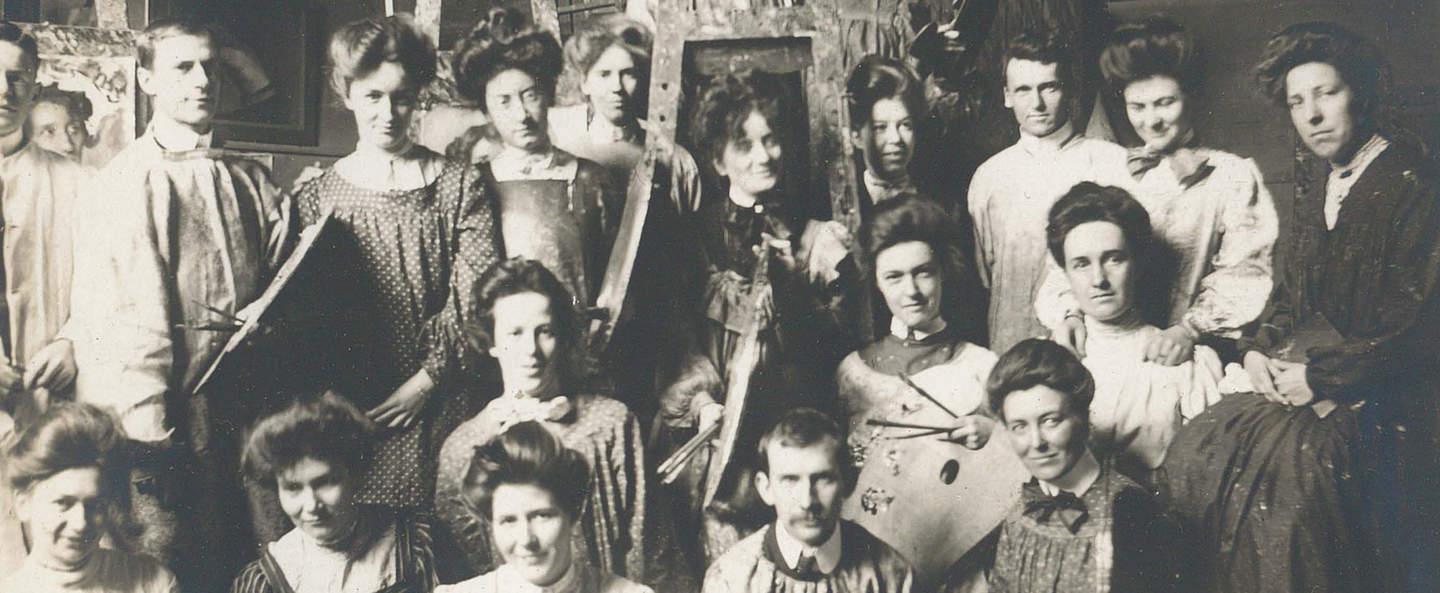Her own path: The National Gallery Art School
Her own path highlights the work of four early 20th century women artists, all of whom have links to Bayside. The women attended The National Gallery Art School in Melbourne around the turn of the 20th century, a time when unprecedented numbers of professionally trained female artists emerged from art schools.
Here, we explore their time at art school and present rare photographs which feature Jessie Traill, Janet Cumbrae Stewart and Norah Gurdon, who all started at the National Gallery Art School together in 1901 and were lifelong friends.

National Gallery Art School, Melbourne c.1901-1906, Janet Cumbrae-Stewart photo album. Private collection, Melbourne.
These images appear larger in the gallery box
About
The National Gallery Art School began in 1867 and operated in small rooms of the National Gallery in Swanston Street, Melbourne (now the State Library of Victoria). Some of Australia’s most well-known artists attended the school, ranging from Hugh Ramsay to Margaret Preston and Joy Hester. Up until around 1910, it was considered to offer the best art training in Australia. Its heads of school and teachers of painting included Eugene von Gerard, George Frederick Folingsby, Frederick McCubbin and Bernard Hall.
The early years of teaching at the National Gallery Art School were rather conservative and involved copying paintings from the connecting picture galleries. By the turn of the century, the classes were similar to the European Academy schools where teaching included drawings with charcoal based on plaster casts and then from life models.
The images shown in the gallery above feature three of the women from Her Own Path; Janet Cumbrae Stewart, Jessie Traill and Norah Gurdon, who all came from affluent Brighton families and started at National Gallery Art School together in 1901, remaining lifelong friends. These photographs reflect the prevalence of women studying at the National Gallery Art School around the turn of the century. From the 1880s until the 1930s, unprecedented numbers of professionally trained female artists emerged from art schools. For example, during Frederick McCubbin’s tenure as drawing master at the National Gallery Art School from 1886-1917, women outnumbered men by 3 to 1.[1]
In the late 19th century, young middle-class women were expected to have certain creative skills within the household such as embroidery, playing an instrument and painting and drawing. Therefore, the school played a role as a type of ‘finishing school’ for these young women. For many, a professional career as an artist would not have been taken seriously and instead their interest in art was merely dismissed by their parents.[2] For the women featured in Her Own Path however, art was more than a hobby. It was their profession. They joined art societies, exhibited regularly throughout their lifetime, entered and won prizes and public commissions and some pursued further studies overseas.
Women of Her own path at the National Gallery Art School
Margaret Baskerville enrolled at the National Gallery Art School from 1879-1886 where she studied under OR Campbell and GF Folingsby and attended afternoon life classes conducted by Charles Douglas Richardson, who was to become her husband some thirty years later. In 1885 she was awarded second prize for drawing at the school.
Learn more about Margaret Baskerville
Jessie Traill attended the National Gallery Art School from 1901 to 1906. Her draughtsmanship was recognised in 1902 when she was awarded first prize for drawing anatomical figures. While she was a student at the school, Jessie also joined John Mather’s Austral School of Art, which encouraged plein-air painting that focussed on capturing the atmosphere of the landscape, a practice she continued throughout her life. In 1903 she also began etching classes with Mather which would become the medium in which Traill would have the greatest success.
Learn more about Jessie Traill.
Janet Cumbrae Stewart also joined John Mather on his outdoor sketching trips before attending the National Gallery Art School between 1901 and 1907, under Bernard Hall and Frederick McCubbin, despite her father’s resistance. In 1905 she was awarded second place in the National Gallery travelling scholarship competition.
Learn more about Janet Cumbrae Stewart
Norah Gurdon studied at the National Gallery Art school from 1901 to 1908 while under the direction of Bernard Hall, who was admired for his consistent treatment and support of women artists.[3] During her time at the Gallery School she became close friends with fellow professional artists Jessie Traill, Janet Cumbrae Stewart, Vida Lahey and Dora Wilson.
Following her father’s initial resistance to her request to enrol at the National Gallery Art School, Clarice Beckett enrolled at the school in 1914, under the condition that she was to be chaperoned by her sister Hilda. At 27, she was a mature-aged student and was around ten years older than her fellow students. She studied the three year drawing class under popular painter and teacher Frederick McCubbin, and opted for further studies with tonalist Max Meldrum at his newly opened school rather than continuing a fourth year course in oil painting at the National Gallery Art School under the conservative Bernard Hall.
Learn more about Clarice Beckett
_________________________________________________________
[1] McCulloch, Alan, McCulloch, Susan, and McCulloch, Emily, The new McCulloch's encyclopedia of Australian art / Alan McCulloch, Susan McCulloch, Emily McCulloch Childs, Aus Art Editions in association with The Miegunyah Press, Fitzroy, Vic, 2006, p.1036
[2] Burke, Janine & Ewing and George Paton Galleries Australian women artists, 1840-1940. Greenhouse Publications, Collingwood, Vic, 1980 p.25
[3] Oliver, Jo, Jessie Traill : a biography, Arden, an imprint of Australian Scholarly Publishing, North Melbourne, Vic, 2020, p.25
Do you want to know what's on in Bayside?
Subscribe to the Bayside Arts monthly e-newsletter and you'll receive the latest news, public program information and invites to exhibition openings.














